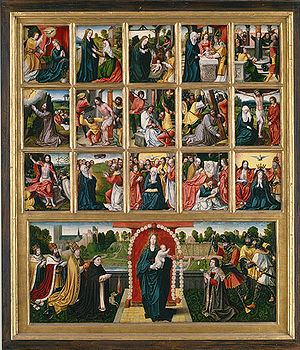
The Holy Rosary, also known as the Dominican Rosary, or simply the Rosary, refers to a set of prayers used in the Catholic Church and to the string of knots or beads used to count the component prayers. When referring to the prayer, the word is usually capitalized ; when referring to the beads, it is written with a lower-case initial letter.

Queen of Heaven is a title given to the Virgin Mary, by Christians mainly of the Catholic Church and, to a lesser extent, in Anglicanism, Lutheranism, and Eastern Orthodoxy.
The First Saturdays Devotion, also called the Act of Reparation to the Immaculate Heart of the Blessed Virgin Mary, is a Catholic devotion which, according to Sister Lúcia of Fátima, was requested by the Virgin Mary in an apparition at Pontevedra, Spain, in December 1925. This devotion has been approved by the Roman Catholic Church.
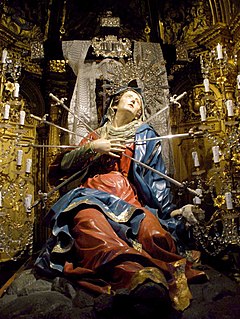
Our Lady of Sorrows, Our Lady of Dolours, the Sorrowful Mother or Mother of Sorrows, and Our Lady of Piety, Our Lady of the Seven Sorrows or Our Lady of the Seven Dolours are names by which Mary, mother of Jesus, is referred to in relation to sorrows in life. As Mater Dolorosa, it is also a key subject for Marian art in the Catholic Church.

In Catholic tradition, the Five Holy Wounds, also known as the Five Sacred Wounds or the Five Precious Wounds, are the five piercing wounds that Jesus Christ suffered during his crucifixion. The wounds have been the focus of particular devotions, especially in the late Middle Ages, and have often been reflected in church music and art.
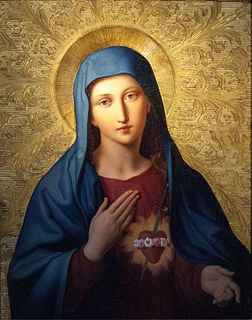
The Immaculate Heart of Mary is a Roman Catholic devotional name used to refer to the Catholic view of the interior life of Mary, mother of Jesus, her joys and sorrows, her virtues and hidden perfections, and, above all, her virginal love for God the Father, her maternal love for her son Jesus Christ, and her motherly and compassionate love for all mankind. Traditionally, the Immaculate Heart is depicted pierced with seven swords or wounds, in homage to the seven dolors of Mary and roses, usually red or white, wrapped around the heart.

The Franciscan Crown is a rosary consisting of seven decades in commemoration of the Seven Joys of the Virgin, namely, the Annunciation, the Visitation, the Nativity of Jesus, the Adoration of the Magi, the Finding in the Temple, the Resurrection of Jesus, and finally, either or both the Assumption of Mary and the Coronation of the Virgin. Devotion to the seven joys of Mary is found in a variety of forms and communities. It is especially popular with the Franciscans, Cistercians, and the Annunciades of St. Joan of France. The devotion was granted many indulgences by different Popes, becoming the most heavily indulgenced devotion in the Church. In order for any associated indulgences to be received it was not necessary for a Franciscan rosary to have been blessed or even to use beads at all.

Marian devotions are external pious practices directed to the person of Mary, mother of God, by members of certain Christian traditions. They are performed in Catholicism, High Church Lutheranism, Anglo-Catholicism, Eastern Orthodoxy and Oriental Orthodoxy, but generally rejected in other Christian denominations.

Catholic devotions are particular customs, rituals, and practices of worship of God or honour of the saints which are in addition to the liturgy of the Catholic Church. The United States Conference of Catholic Bishops describes devotions as "expressions of love and fidelity that arise from the intersection of one's own faith, culture and the Gospel of Jesus Christ". Devotions are not considered part of liturgical worship, even if they are performed in a church or led by a priest, but rather they are paraliturgical. The Congregation for Divine Worship at the Vatican publishes a Directory on Popular Piety and the Liturgy.
A chaplet is a form of Christian prayer which uses prayer beads, and which is similar to but distinct from the Rosary. Some chaplets have a strong Marian element, others focus more directly on Jesus Christ and his Divine Attributes, or one of the many saints, such as the Chaplet of St Michael. Chaplets are "personal devotionals" and depending on the origins, each one of the chaplets may vary considerably. In the Roman Catholic Church, while the usual five-decade Dominican rosary is also considered to be a chaplet, the other chaplets often have fewer beads and decades than a traditional rosary and may even a different set of prayers. In the Anglican Communion, a chaplet often includes one week of the Anglican rosary.

Mary, the mother of Jesus in Christianity, is known by many different titles, epithets, invocations, and several names associated with places.

Rosary-based prayers are Christian prayers said on a set of rosary beads, among other cords. These prayers recite specific word sequences on different parts of the rosary beads. They may be directed to Jesus Christ, the Virgin Mary or God the Father.
Marian feast days are specific holy days of the liturgical year recognized by Christians as significant Marian days for the celebration of events in the life of the Blessed Virgin Mary and her veneration. The number of Marian feasts celebrated, their names can vary among Christian denominations.

The history of Catholic Mariology traces theological developments and views regarding Mary from the early Church to the 21st century. Mariology is a mainly Catholic ecclesiological study within theology, which centers on the relation of Mary, the Mother of God, and the Church. Theologically, it not only deals with her life but with her veneration in life and prayer, in art, music, and architecture, from ancient Christianity to modern times.

Throughout history, Catholic Mariology has been influenced by a number of saints who have attested to the central role of Mary in God's plan of salvation. The analysis of Early Church Fathers continues to be reflected in modern encyclicals. Irenaeus vigorously defended the title of "Theotokos" or Mother of God. The views of Anthony of Padua, Robert Bellarmine and others supported the doctrine of the Immaculate Conception of the Virgin Mary, which was declared a dogma in 1850.
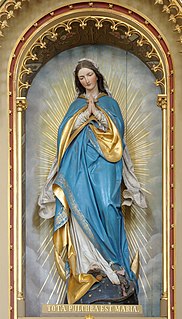
The Mariology of the popes is the theological study of the influence that the popes have had on the development, formulation and transformation of the Roman Catholic Church's doctrines and devotions relating to the Blessed Virgin Mary.
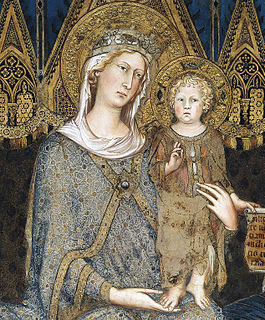
The veneration of Mary, mother of Jesus in the Catholic Church encompasses various Marian devotions which include prayer, pious acts, visual arts, poetry, and music devoted to the Virgin Mary. Popes have encouraged it, while also taking steps to reform some manifestations of it. The Holy See has insisted on the importance of distinguishing "true from false devotion, and authentic doctrine from its deformations by excess or defect". There are significantly more titles, feasts, and venerative Marian practices among Roman Catholics than in other Western Christian traditions. The term hyperdulia indicates the special veneration due to Mary, greater than the ordinary dulia for other saints, but utterly unlike the latria due only to God.

Mary has been one of the major subjects of Western Art for centuries. Numerous pieces of Marian art in the Catholic Church covering a range of topics have been produced, from masters such as Michelangelo and Botticelli to works by unknown artists.

The Chaplet of the Seven Sorrows, also known as the Rosary of the Seven Sorrows or the Servite Rosary, is a Rosary based prayer that originated with the Servite Order. It is often said in connection with the Seven Dolours of Mary.

The Queen of Angels Foundation is an association of lay faithful of the Catholic Church dedicated to fostering devotion to Mary, Mother of Jesus. The Foundation is a volunteer group of lay men and women who "...strive together in a common endeavor to foster a more perfect life for themselves and their community by promoting reverence for the Blessed Virgin Mary, in whose name, as Our Lady of the Angels, the City and Archdiocese of Los Angeles were founded..." and whom Catholics revere as Queen of Heaven and Empress of the Americas.
